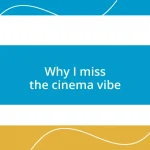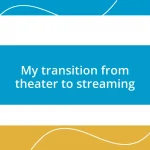Key takeaways:
- Film accessibility enhances storytelling by allowing diverse audiences, including those with disabilities, to engage fully with narratives through features like audio descriptions and closed captions.
- Traditional filmmaking faces barriers such as insufficient funding for inclusive practices and inadequate theater accessibility, which alienates significant portions of the audience.
- The future of film accessibility is promising with technological advancements, such as real-time captioning and interactive storytelling, which could revolutionize how films are experienced by all viewers.

Understanding film accessibility importance
Film accessibility is crucial because it allows everyone to experience the magic of storytelling, regardless of their abilities. I remember watching a movie with a close friend who is deaf; the way they engaged with subtitles and visual storytelling opened my eyes. It made me wonder: how many moments are we missing when we don’t consider the diverse ways people connect with film?
When we ignore accessibility, we risk alienating a significant portion of our audience. Just think about the last time a film you loved was inaccessible to someone else. It struck me when my roommate, who uses a wheelchair, expressed frustration over inaccessible cinema entrances. That moment was a wake-up call about the importance of inclusivity in all aspects of film.
Moreover, accessible films pave the way for broader discussions about representation and empathy. For instance, I felt a deeper connection to characters when I watched films with audio descriptions; it was like discovering hidden layers within the narrative. Aren’t stories meant to unite us? Making films accessible is not just about meeting standards; it’s about cultivating a community where everyone can feel seen and heard.

Barriers in traditional filmmaking
Traditionally, filmmaking tends to rely heavily on visual storytelling, which creates a barrier for those with visual impairments. I remember attending a screening where the absence of audio descriptions left me feeling lost, as the subtle visual cues were lost on me. It made me appreciate, even more, how crucial it is to integrate descriptions that allow everyone to visualize the story being told.
Another challenge is the lack of resources allocated for inclusivity in film production. I once spoke with a filmmaker who recounted how implementing sign language interpretation required additional funding and time—a luxury that many indie films simply don’t have. If only the industry recognized that these adjustments enrich the storytelling experience for all audiences, we’d likely see a transformative shift in how films are made.
Lastly, most traditional theaters aren’t designed with accessibility in mind. I still recall the discomfort of a friend who uses a wheelchair struggling to navigate narrow aisles during a premiere. This highlights a physical barrier that screams for change, reminding us that inclusivity must extend beyond the screen and into the very spaces where stories unfold.
| Barrier Type | Description |
|---|---|
| Visual Impairment | Lack of audio descriptions limits engagement for visually impaired audiences. |
| Resource Allocation | Insufficient funding for inclusive practices hinders broader storytelling. |
| Theater Accessibility | Traditional theaters often lack adequate facilities for people with mobility challenges. |

Essential features for accessible films
Accessible films should incorporate features that cater to diverse audiences, ensuring everyone can engage fully with the story. I remember watching a documentary that included sign language interpretation, and it transformed the viewing experience for everyone in the room. It was a simple addition that created a sense of shared understanding and participation, reminding me of the importance of incorporating multiple formats for diverse needs.
To foster accessibility in film, here are some essential features to consider:
- Audio Descriptions: Narration that explains critical visual elements for visually impaired viewers.
- Closed Captions: Text on screen that provides dialogue and sound cues, enhancing comprehension for deaf and hard-of-hearing audiences.
- Sign Language Interpretation: On-screen interpreters that make films accessible for the deaf community.
- Visual Storytelling Elements: Incorporating strong visual narratives and character expressions that convey emotion, making it easier for those with hearing impairments to connect with the story.
- Flexible Viewing Options: Allowing viewers to select audio or captioning preferences to tailor their viewing experience.
- Subtitles in Multiple Languages: Providing translations can also expand film accessibility to various cultural groups and promote inclusivity.
When I participated in a film festival that prioritized accessibility, I was amazed at how designers considered seating arrangements and technology to accommodate diverse needs. It was enlightening to see how such thoughtful planning can create a more inclusive space—one where every story can be appreciated, and every voice can be heard.

Technology’s role in film accessibility
Technology has become a transformative force in making films more accessible. I vividly recall the first time I used a streaming platform that offered audio descriptions. It felt as though a veil had been lifted, allowing me to fully immerse myself in the narrative. Suddenly, the subtle imagery and nuances I would have otherwise missed became vibrant and alive, enriching my overall experience.
Moreover, advancements in mobile apps have played a significant role in accessibility. I often think about how a friend of mine with hearing impairment downloaded an app that provided real-time captions during a live screening. Imagine sitting in a packed theater, feeling connected to the dialogue while everyone else is laughing or gasping at the same moments. It was a bond created through technology, showing just how powerful these tools can be in bridging gaps.
As I explore this topic, I can’t help but wonder: how can we leverage technology even further? With virtual reality (VR) and augmented reality (AR) gaining traction, could these innovations provide even deeper layers of accessibility? I definitely believe they hold extraordinary potential. The future of film accessibility is not just about viewing the story but experiencing it in a way that is enriching for everyone.

Best practices for inclusive production
To create an inclusive film production, it’s essential to involve diverse voices from the onset. When I worked on a short film project, we had a diverse team—from writers to actors—which broadened our creative perspective immensely. This collaboration not only enriched our storytelling but also ensured we were mindful of the various accessibility features we needed to incorporate early in the process.
Training for the entire cast and crew on accessibility best practices can make a world of difference. I recall a workshop I attended that focused specifically on inclusivity in storytelling. It not only opened my eyes to the challenges others face but also empowered us to be advocates for accessibility on set. Imagine the impact of having a production team that genuinely understands the importance of accessible storytelling; it creates a culture of empathy that resonates throughout the entire project.
Finally, conducting audience testing with diverse viewers can provide invaluable insights into how accessible a film truly is. On one occasion, after screening a short film to a mixed group, we received candid feedback that shaped our understanding of what worked and what didn’t. This direct interaction helped us refine our approach, proving that inclusion isn’t just an afterthought—it’s a continuous process of learning and adapting. How often do we ask our audiences what they need? Listening to them is crucial for creating stories that resonate widely.

Evaluating film accessibility impact
Evaluating film accessibility impact requires careful consideration of how different accessibility features enhance the viewing experience for diverse audiences. I remember attending a film festival where a feature film was screened with open captions. Seeing everyone, regardless of their hearing ability, laughing at the same jokes sparked a realization for me: inclusivity creates a shared emotional journey. It was as if the entire audience was part of a vibrant community, connected by the same narrative.
On a different occasion, a friend of mine who is visually impaired shared her experience watching a film with descriptive audio incorporated. She articulated how the descriptions elevated her understanding and engagement with the plot. Hearing her emotional reflection made me ask myself: how many people without accessibility features miss out on such enriching experiences? The ability to connect emotionally through stories shouldn’t be limited by barriers; it should be accessible to all.
The impact of accessibility is evident not just in individual experiences but in the overall reception of a film. I once participated in a panel discussion where we analyzed viewer feedback regarding a recently released film that implemented various accessibility measures. The consensus was clear: films that embrace accessibility not only reach wider audiences but also generate more positive reviews. This leaves me wondering—could expanding accessibility measures directly influence a film’s box office success? In my view, investing in inclusivity is not just a moral obligation; it’s a savvy business strategy that pays off on multiple levels.

Future trends in film accessibility
The future of film accessibility is likely to see significant advancements with the integration of technology. For instance, I recently attended a workshop showcasing a new app that provides real-time captioning and audio descriptions while watching films in theaters. It was thrilling to think about how such innovations could empower individuals to experience content in a more engaged and personal way. Can you imagine a future where every film comes with customizable accessibility options right at your fingertips?
Moreover, the trend toward virtual reality and interactive storytelling could reshape accessibility norms. I vividly recall an immersive VR experience where I interacted with a digitally created environment alongside a group of people with varying abilities. It underscored the potential for storytelling that adapts to individual needs, making narratives not just accessible but also tailored to enhance every viewer’s experience. If we can build films that respond to the unique preferences of diverse audiences, shouldn’t we strive to do just that?
Furthermore, a collective push toward industry-wide regulations on accessibility may be on the horizon. I often think about discussions I’ve had with industry peers who recognize that policy changes could usher in a new era of accountability. Just envisioning a world where studios prioritize accessibility from the outset—not as an afterthought but as a core principle. What might that say about our commitment to inclusivity? I believe it would reflect an acknowledgment that everyone deserves to experience the magic of film, and frankly, that’s a movement worth championing.












